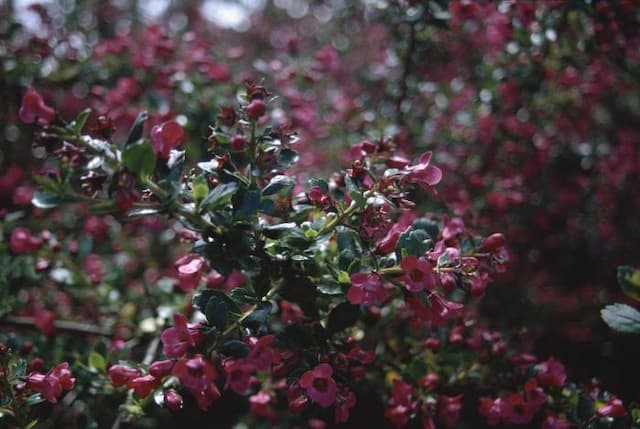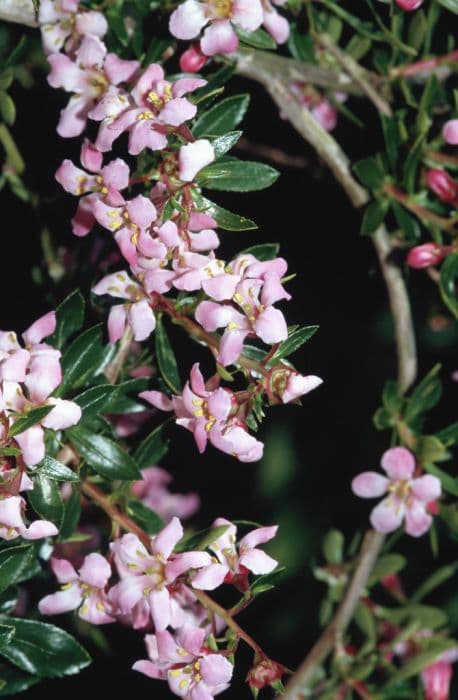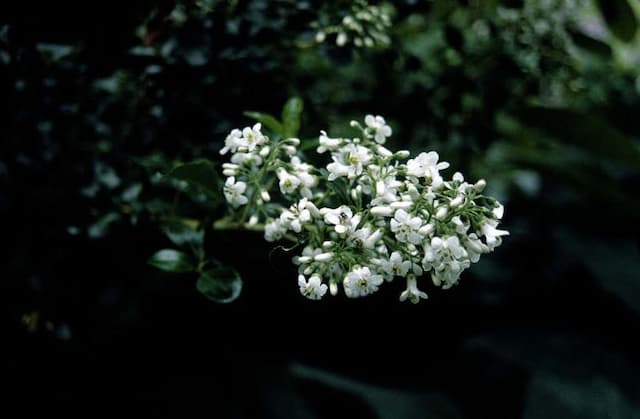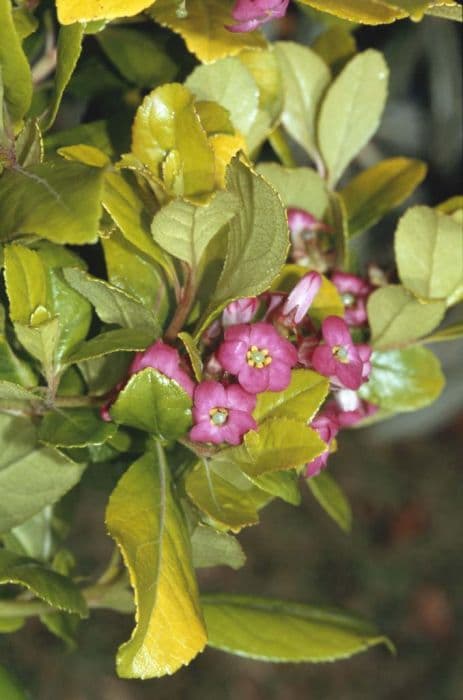Escallonia Escallonia 'Peach Blossom'

ABOUT
Escallonia 'Peach Blossom' is an attractive evergreen shrub that is known for its lush foliage and charming flowers. The leaves of the plant are small, glossy, and have a deep green color with a leathery texture. They are oval-shaped and sometimes exhibit a finely serrated edge, giving them a slightly jagged appearance. These leaves are arranged densely on the branches, creating a full and bushy look. The most striking feature of Escallonia 'Peach Blossom' is its flowers, which bloom in abundance. The flowers are small, trumpet-shaped, and exhibit a delicate peach-pink hue with a gentle gradient, appearing almost as if they're blushing. If you look closely, you can see tiny yellow centers that add an extra touch of color contrast and interest. The blooms are clustered together in groups, forming showy inflorescences that can cover much of the plant when in full bloom, creating a cloud of pink that is quite eye-catching. Overall, the appearance of Escallonia 'Peach Blossom' is one of both vibrancy and serenity, as its bright flowers provide a lively splash against the calm backdrop of its dense green foliage. Its aesthetically pleasing presence makes it a beloved choice for ornamental gardens, hedges, and as a feature plant in landscape designs.
About this plant
 Names
NamesFamily
Escalloniaceae.
Synonyms
Escallonia, Peach Blossom.
Common names
Escallonia x exoniensis 'Fradesii', Escallonia 'Fradesii'.
 Toxicity
ToxicityTo humans
Escallonia 'Peach Blossom', commonly known as Escallonia, is not widely regarded as a poisonous plant to humans. There is limited information on its toxicity, and it is generally not listed among the commonly toxic plants. However, the lack of reported toxicity does not necessarily guarantee that it is safe to ingest. It is advisable to avoid consuming any part of this plant to prevent possible adverse reactions, which might vary from individual to individual.
To pets
Escallonia 'Peach Blossom', commonly referred to as Escallonia, is not commonly known to be toxic to pets such as dogs and cats. While there is a lack of substantial evidence and documented cases of poisoning from this specific plant, it is always best to ensure pets do not ingest garden plants as individual animals may react differently. Monitoring your pet for any signs of distress after ingestion, such as vomiting, diarrhea, or unusual behavior, and seeking veterinary attention if any of these symptoms occur is a good precautionary measure.
 Characteristics
CharacteristicsLife cycle
Perennials
Foliage type
Evergreen
Color of leaves
Green
Flower color
Pink
Height
3-4 feet (0.91-1.22 meters)
Spread
3-4 feet (0.91-1.22 meters)
Plant type
Shrub
Hardiness zones
7-9
Native area
South America
Benefits
 General Benefits
General Benefits- Attractive Flowers - Escallonia 'Peach Blossom' produces pink flowers which add aesthetic appeal to gardens.
- Drought Tolerance - Once established, the plant is relatively drought tolerant, making it suitable for xeriscaping.
- Low Maintenance - Requires minimal pruning and care once it is well established.
- Pollinator Friendly - The flowers attract bees and butterflies, supporting local ecosystems.
- Privacy Screening - Can be used to create hedges or screens for added privacy due to its bushy growth.
- Erosion Control - The plant's root system helps to stabilize the soil, preventing erosion on slopes.
- Hardiness - Escallonia 'Peach Blossom' is relatively hardy and can withstand a variety of climates.
- Year-Round Interest - Evergreen foliage provides interest in the garden throughout the entire year.
- Deer Resistance - The plant is known to be deer resistant, which can be advantageous in areas with deer populations.
- Versatility - Suitable for borders, containers, and coastal gardens, providing flexibility in landscaping uses.
 Medical Properties
Medical PropertiesThis plant is not used for medical purposes.
 Air-purifying Qualities
Air-purifying QualitiesThis plant is not specifically known for air purifying qualities.
 Other Uses
Other Uses- Escallonia 'Peach Blossom' can be used in coastal gardens as it is resistant to salt spray and can help in stabilizing slopes and banks.
- The dense and evergreen nature of the plant makes it an excellent choice for privacy hedges or living screens in residential and urban environments.
- The plant's propensity for attracting bees and butterflies can be leveraged by placing it in pollinator gardens to support local wildlife and biodiversity.
- Escallonia 'Peach Blossom' can be pruned into topiary shapes, providing ornamental value to formal gardens and landscapes.
- The wood from pruned branches can be repurposed in hobby woodworking to create small decorative objects or in floral arrangements.
- Its tolerance to wind makes it a suitable natural windbreak for protecting more delicate plants in a mixed border arrangement.
- When planted alongside roadways, it can provide a natural barrier to dust and reduce soil erosion on embankments.
- Escallonia 'Peach Blossom' can be used as a natural habitat for small birds, providing shelter and nesting sites in its dense foliage.
- The robust root system of the plant can be beneficial in reclamation projects to help stabilize soils and restore native plant communities.
- Dried leaves and flowers of the plant could potentially be used in potpourri blends for a subtle, natural fragrance in the home.
Interesting Facts
 Feng Shui
Feng ShuiThe Escallonia is not used in Feng Shui practice.
 Zodiac Sign Compitability
Zodiac Sign CompitabilityThe Escallonia is not used in astrology practice.
 Plant Symbolism
Plant Symbolism- Harmony: The delicate appearance of the Peach Blossom asserts a sense of balance and togetherness in its surroundings.
- Rebirth: As a plant that flowers profusely in spring, it symbolizes new beginnings and the renewal of nature.
- Femininity: The soft pink hues of the flowers are often associated with gentle feminine qualities and grace.
- Prosperity: In many cultures, blossoms like those of the Peach Blossom are seen as indicators of wealth and prosperity to come.
- Eternal Love: The lush, continuous blooming can represent enduring affection in romantic relationships.
- Beauty: The aesthetically pleasing aspect of the plant mirrors the human admiration for beauty in various forms.
- Protection: Sometimes plants are believed to offer a protective quality, and the robust nature of the Peach Blossom could symbolize shelter or a safe haven.
 Water
WaterThe Escallonia 'Peach Blossom', commonly known as escallonia, should be watered deeply to ensure that the root zone is moistened. It's best to water the plant once a week with about 1 to 1.5 gallons of water, but this may need to be adjusted based on weather conditions. During hot, dry spells, watering may need to be increased, while in cooler, wetter weather, it can be reduced. Always check the soil moisture before watering; the top inch of the soil should be dry to the touch before you water again.
 Light
LightEscallonia 'Peach Blossom' thrives best in full sun, which equates to at least six hours of direct sunlight daily. The ideal spot for the plant is in an area where it can receive unfiltered sunlight throughout the day. However, in regions with extremely hot, intense sun, it may benefit from some afternoon shade to prevent stress.
 Temperature
TemperatureEscallonia 'Peach Blossom' can withstand a range of temperatures but prefers milder conditions. The ideal temperature range for this plant is between 50°F and 75°F. It can tolerate minimum temperatures down to about 10°F but should be protected from frost to prevent damage. At the other extreme, it may need protection or adequate watering if temperatures exceed 85-90°F to prevent heat stress.
 Pruning
PruningEscallonia 'Peach Blossom' should be pruned to maintain its shape and encourage more robust growth. The best time to prune is in late winter or early spring before new growth starts. Prune up to one-third of the old growth to keep the plant looking tidy and to promote the development of new blossoms. It can also be pruned lightly after flowering to remove spent blooms and encourage a second flush of flowers.
 Cleaning
CleaningAs needed
 Soil
SoilEscallonia 'Peach Blossom', commonly known as Escallonia, thrives best in a soil mix that is rich in organic matter, well-draining, and has a slightly acidic to neutral pH of about 6.0 to 7.0. An ideal mix might include two parts loam, one part peat moss or compost, and one part sharp sand or perlite to enhance drainage.
 Repotting
RepottingEscallonia plants don't need frequent repotting and can do well if repotted every 2-3 years. It is best to repot in the spring, just before the growing season begins.
 Humidity & Misting
Humidity & MistingEscallonia plants prefer moderate to high humidity levels but are quite adaptable and can tolerate a range of humidity conditions so long as they are not in an excessively dry environment.
 Suitable locations
Suitable locationsIndoor
Place Escallonia in bright light and ensure good air circulation.
Outdoor
Plant in well-drained soil, full sun to partial shade.
Hardiness zone
7-10 USDA
 Life cycle
Life cycleEscallonia 'Peach Blossom' begins its life as a seed that germinates in well-draining soil, given the right conditions of warmth and moisture. The seedling stage follows, where the young plant develops its first true leaves and establishes a root system. Once mature enough, it enters the vegetative stage, characterized by vigorous foliage growth and the development of a robust, bushy structure. In its reproductive stage, typically during late spring to summer, it produces clusters of fragrant, pink to peach-colored flowers that attract pollinators. After pollination, it sets small capsules containing seeds, which, when mature, are dispersed for propagation. Throughout its life, the plant will experience cycles of growth, flowering, and dormancy, particularly in colder climates where it may lose leaves in winter before regenerating in the spring.
 Propogation
PropogationPropogation time
Spring-Early Summer
The most popular method of propagating Escallonia 'Peach Blossom' is through semi-hardwood cuttings. This process typically occurs in summer when new growth has partially matured. One would cut a 4 to 6-inch-long (10 to 15 cm) piece of stem just below a leaf node, strip the bottom leaves, and possibly dip the cut end in a rooting hormone for better success. The cutting is then planted in a pot filled with a moist, well-draining potting mix and covered with a plastic bag or placed in a greenhouse to maintain humidity. The cutting should be kept out of direct sunlight and the soil should remain moist until roots have developed, usually in a few weeks to a couple of months, after which it can be transplanted to a more permanent location.


![Escallonia [Golden Carpet]](/_next/image?url=https%3A%2F%2Fplants-admin.emdemapps.com%2Fimages%2Fplants%2F%2Fimages%2F604b59284be41.png&w=640&q=75)


![Escallonia [Pink Elle]](/_next/image?url=https%3A%2F%2Fplants-admin.emdemapps.com%2Fimages%2Fplants%2F%2Fimages%2F604b630962bc2.png&w=640&q=75)



